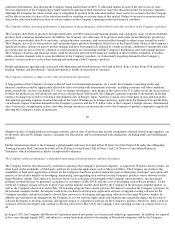Apple 2002 Annual Report Download - page 25
Download and view the complete annual report
Please find page 25 of the 2002 Apple annual report below. You can navigate through the pages in the report by either clicking on the pages listed below, or by using the keyword search tool below to find specific information within the annual report.
estimates these restructuring actions will result in reduced quarterly operating expenses of approximately $10 million.
Of the $30 million restructuring charge for fiscal 2002, $6 million was incurred in the fourth quarter of 2002 related to actions designed to
reduce headcount costs in Corporate operations and sales and to adjust its PowerSchool product strategy. Headcount actions, primarily in
Corporate operations, sales, and PowerSchool related research and development, resulted in the elimination of approximately 180 positions
worldwide at a cost of $1.8 million. The shift in product strategy at PowerSchool included discontinuing development and marketing of a
PowerSchool product that resulted in the impairment of previously capitalized development costs associated with the product in the amount of
$4.5 million. The remaining charge in 2002 of $24 million was incurred in the first quarter of 2002 and will ultimately result in the elimination
of approximately 425 positions worldwide, 415 of which were eliminated by September 28, 2002, at a cost of $8 million. Positions were
eliminated primarily in the Company's operations, information systems, and administrative functions. In addition, these restructuring actions
also included significant changes in the Company's information systems strategy resulting in termination of equipment leases and cancellation
of existing projects and activities. Related lease and contract cancellation charges totaled $12 million, and charges for asset impairments totaled
$4 million. Of the total charge in 2002 of $30 million, substantially all had been spent by September 28, 2002, except for approximately
$1 million related primarily to future payments on abandoned operating leases.
2000 Restructuring Actions
During the first quarter of 2000, the Company initiated restructuring actions resulting in recognition of an $8 million restructuring charge. This
charge was comprised of $3 million for the write-off of various operating assets and $5 million for severance payments to approximately 95
employees associated with consolidation of various domestic and international sales and marketing functions. Of the $5 million accrued for
severance, $2.5 million had been spent before the end of 2000, and the remainder was spent in 2001. Of the $3 million accrued for the write-
off
of various assets, substantially all was utilized before the end of 2000.
29
Purchased In
-Process Research and Development (IPR&D)
During the fourth quarter of 2002, the Company acquired Emagic GmbH, a provider of professional software solutions for computer based
music production, for approximately $30 million in cash; $551,000 of which was allocated to IPR&D. The amount of the purchase price
allocated to IPR&D was expensed upon acquisition, because the technological feasibility of products under development had not been
established and no alternative future uses existed. The IPR&D relates primarily to Emagic's Logic series technology and extensions. At the date
of the acquisition, the products under development were between 43%-83% complete, and it was expected that the remaining work would be
completed during the Company's fiscal 2003 at a cost of approximately $415,000. The remaining efforts include finalizing user interface design
and development, and testing. The fair value of the IPR&D was determined by an independent third-
party valuation using the income approach,
which reflects the projected free cash flows that will be generated by the IPR&D projects and that are attributable to the acquired technology,
and discounting the projected net cash flows back to their present value using a discount rate of 25%.
In May 2001, the Company acquired PowerSchool, Inc. (PowerSchool), a provider of web-based student information systems for K-12 schools
and districts that enables schools to record, access, report, and manage their student data and performance in real-time, and gives parents real-
time web access to track their children's progress. Of total purchase consideration of $66.1 million, $10.8 million was allocated to IPR&D and
was expensed upon acquisition because the technological feasibility of products under development had not been established and no alternative
future uses existed. The IPR&D relates to technologies representing processes and expertise employed to design, develop, and deploy a
functioning, scalable web-based student information system for use by K-12 schools. At the date of the acquisition, the PowerSchool product
under development was approximately 50% complete, and it was expected that the remaining 50% would be completed during the Company's
fiscal 2002 at a cost of approximately $9.25 million. The remaining efforts, which were completed during 2002, included completion of coding,
finalizing user interface design and development, and testing. The fair value of the IPR&D was determined by an independent third-party
valuation using the income approach, which reflects the projected free cash flows that will be generated by the IPR&D projects and that are
attributable to the acquired technology, and discounting the projected net cash flows back to their present value using a discount rate of 25%.
Executive Bonus
During the first quarter of 2000, the Company's Board of Directors approved a special executive bonus for the Company's Chief Executive
Officer for past services in the form of an aircraft with a total cost to the Company of approximately $90 million, the majority of which was not
tax deductible. Approximately half of the total charge was for the cost of the aircraft. The other half represents all other costs and taxes
associated with the bonus. In the fourth quarter of 2002, all significant work and payments associated with the aircraft were complete. Of the
original $90 million accrual, $2.4 million remained unspent at the end of fiscal 2002 and was reversed.
30
Other Income and Expense
























